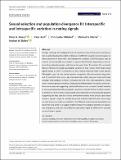Files in this item
Sexual selection and population divergence III : interspecific and intraspecific variation in mating signals
Item metadata
| dc.contributor.author | Moran, Peter | |
| dc.contributor.author | Hunt, John | |
| dc.contributor.author | Mitchell, Christopher | |
| dc.contributor.author | Ritchie, Michael Gordon | |
| dc.contributor.author | Bailey, Nathan William | |
| dc.date.accessioned | 2020-04-28T08:30:02Z | |
| dc.date.available | 2020-04-28T08:30:02Z | |
| dc.date.issued | 2020-07 | |
| dc.identifier | 267341975 | |
| dc.identifier | dba30e45-e796-41c3-b8d9-bc39ed565995 | |
| dc.identifier | 85084156214 | |
| dc.identifier | 000528739200001 | |
| dc.identifier.citation | Moran , P , Hunt , J , Mitchell , C , Ritchie , M G & Bailey , N W 2020 , ' Sexual selection and population divergence III : interspecific and intraspecific variation in mating signals ' , Journal of Evolutionary Biology , vol. 33 , no. 7 , pp. 990-1005 . https://doi.org/10.1111/jeb.13631 | en |
| dc.identifier.issn | 1010-061X | |
| dc.identifier.other | ORCID: /0000-0001-7913-8675/work/73293035 | |
| dc.identifier.other | ORCID: /0000-0003-3531-7756/work/73293804 | |
| dc.identifier.uri | https://hdl.handle.net/10023/19860 | |
| dc.description | Funding: Orthopterists' Society, Natural Environment Research Council (Grant Number(s): NE/G00949X/1, NE/G014906/1, NE/L011255/1), ARC (Grant Number(s): DP180101708). | en |
| dc.description.abstract | A major challenge for studying the role of sexual selection in divergence and speciation is understanding the relative influence of different sexually selected signals on those processes in both intra‐ and interspecific contexts. Different signals may be more or less susceptible to co‐option for species identification depending on the balance of sexual and ecological selection acting upon them. To examine this, we tested three predictions to explain geographic variation in long‐ versus short‐range sexual signals across a 3,500 + km transect of two related Australian field cricket species (Teleogryllus spp.): (a) selection for species recognition, (b) environmental adaptation and (c) stochastic divergence. We measured male calling song and male and female cuticular hydrocarbons (CHCs) in offspring derived from wild populations, reared under common garden conditions. Song clearly differentiated the species, and no hybrids were observed suggesting that hybridization is rare or absent. Spatial variation in song was not predicted by geography, genetics or climatic factors in either species. In contrast, CHC divergence was strongly associated with an environmental gradient supporting the idea that the climatic environment selects more directly upon these chemical signals. In light of recently advocated models of diversification via ecological selection on secondary sexual traits, the different environmental associations we found for song and CHCs suggest that the impact of ecological selection on population divergence, and how that influences speciation, might be different for acoustic versus chemical signals. | |
| dc.format.extent | 16 | |
| dc.format.extent | 1683191 | |
| dc.language.iso | eng | |
| dc.relation.ispartof | Journal of Evolutionary Biology | en |
| dc.subject | Acoustic signalling | en |
| dc.subject | Character displacement | en |
| dc.subject | Chemical signalling | en |
| dc.subject | Ecological speciation | en |
| dc.subject | Environmental selection | en |
| dc.subject | Multi‐modal signalling | en |
| dc.subject | Sexual selection | en |
| dc.subject | Teleogryllus | en |
| dc.subject | QH301 Biology | en |
| dc.subject | DAS | en |
| dc.subject.lcc | QH301 | en |
| dc.title | Sexual selection and population divergence III : interspecific and intraspecific variation in mating signals | en |
| dc.type | Journal article | en |
| dc.contributor.sponsor | NERC | en |
| dc.contributor.sponsor | NERC | en |
| dc.contributor.institution | University of St Andrews. Centre for Biological Diversity | en |
| dc.contributor.institution | University of St Andrews. Institute of Behavioural and Neural Sciences | en |
| dc.contributor.institution | University of St Andrews. School of Biology | en |
| dc.identifier.doi | https://doi.org/10.1111/jeb.13631 | |
| dc.description.status | Peer reviewed | en |
| dc.identifier.grantnumber | NE/G014906/1 | en |
| dc.identifier.grantnumber | NE/L011255/1 | en |
This item appears in the following Collection(s)
Items in the St Andrews Research Repository are protected by copyright, with all rights reserved, unless otherwise indicated.

